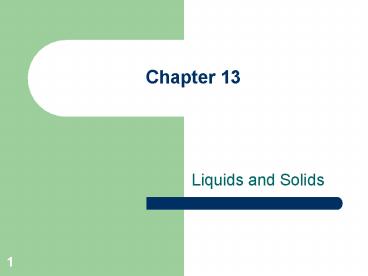Liquids and Solids - PowerPoint PPT Presentation
1 / 31
Title: Liquids and Solids
1
Chapter 13
- Liquids and Solids
2
Compare and Contrast Gases, Liquids and Solids
- Water vapor at 1 atm, temp 20 ?C, and amount if
1 mol. What is its volume? - What is the volume of 1 mol of liquid water at 20
?C? - That is 1300x smaller than the volume occupied by
the same number of molecules (6.0233 x 1023) in
the gas phase.
3
Homework Problems
- 8, 16, 18, 22, 30, 38, 46, 56, 70, and 74.
4
Intermolecular Forces
- The physical state of a substance at a given
temperature and pressure is related to several
factors, which involve intermolecular forces. - Particles with greater mass have a greater
attraction for each other. - The boiling points and melting points of
substances increase with greater molecular mass.
5
Forces Between Particles
- Interionic Forces attractive forces between
ions, and these are some of the strongest forces. - They are due to the attraction of opposite
charges. - Examples Na Cl- Ca2 O2- Al3 N3-
6
Forces Between Particles
- Intramolecular Forces. Forces that hold atoms
together within molecules. Polar and non-polar
covalent bonds. - Examples H-O-H CO
- Intermolecular Forces. The attractive force
between molecules. These forces are weaker than
interionic or intramolecular forces. These
forces help determine the physical properties of
molecular compounds. - Also called van der Waals forces
7
Intermolecular Forces
- Dipole Forces Polar molecules are attracted to
each other via the negative end of one molecule
being attracted to the positive end of another
molecule.
Liquid
Solid
8
Intermolecular Forces
- Hydrogen Bond Bond between hydrogen attached to
an electronegative atom (F, O, or N) to another
electronegative atom.
9
Dispersion Forces
- (London Forces) between nonpolar molecules.
- Examples H2 Br2
10
Intermolecular Forces
- Listed from strongest to weakest
- Hydrogen bondsgtDipole forcesgtDispersion forces.
11
Substances With Stronger Intermolecular Bonds,
Generally Have a
- Lower Vapor Pressure
- Higher Boiling Point
- Higher Melting Point
- Greater Viscosity
- Greater Surface Tension
12
The Liquid State
- Viscosity A measure of the resistance of a
liquid to flow. - Depends on the size of the molecule.
- Type of attractive forces.
- Viscosity decreases with increasing temperature.
13
Properties of Liquids
- Surface Tension resistance of a liquid surface
to penetration by a solid object. - Explains formation of droplets on solid surface.
- Surfactants reduce surface tension.
14
Vaporization and Condensation
- Evaporation transformation from liquid to vapor
(gas phase). - Condensation conversion from vapor to liquid.
- There is an equilibrium between the two phases
- Liquid Vapor
Vaporization
Condensation
15
Boiling Point
- BP is the temperature at which the vapor pressure
of a liquid equals the external pressure
(atmospheric).
16
Distillation
- A volatile component can be separated from a
non-volatile component by distillation. The
volatile component is evaporated and the vapors
are condensed, leaving the non-volatile component
behind.
17
Distillation Apparatus
18
Heat of Vaporization
- Heat is required to vaporize a liquid.
- A liquid that evaporates at room temperature
absorbs heat from the surroundings. - The quantity of heat required to vaporize 1 mol
of liquid is called the molar heat of
vaporization.
19
The Solid State
- Many solids are amorphous. The particles (ions or
molecules) have no definite order. - Examples are glass, rubber, and plastic.
- Crystalline solids have a regular arrangement of
particles, called a crystal lattice. - Some types of crystal lattice are
- simple cubic
- body-centered cubic
- face-centered cubic
20
Common Crystal Lattices
21
Solids may be classified by the type of
inter-particle force.
- Ionic solids Ions are at each lattice point in
the crystal. - Molecular solids Have discrete molecules at each
lattice point. Held together by intermolecular
forces. - Covalent network or macromolecular solids have
atoms at the lattice points. They are held
together by covalent bonds. Examples are SiC,
graphite and diamond.
22
Allotropes
- Carbon and other elements can exist in various
forms. These forms are called allotropes. - Allotropes of carbon are graphite, amorphous, and
diamond, and nanotubes. These are
macromolecular. - A molecular allotrope is Buckminsterfulleranes.
23
- The Structure of Diamond, an Allotrope of Carbon
24
Graphite, an Allotrope of Carbon
25
Buckminsterfullerene, an Allotrope of Carbon
26
Melting and Freezing
- When a crystalline solid is heated, particles
vibrate more vigorously and become liquid. - This process is called melting.
- When a substance changes from a liquid to a solid
the process is called freezing. - Liquids and solids are in dynamic equilibrium
- Solid Liquid
melting
freezing
27
Heat of Fusion
- The amount of heat required to convert 1
mol of a solid to a liquid is called the molar
heat of fusion.
28
Heating and Cooling Curves
- Specific heat capacity amount of heat needed to
raise the temperature of 1 g of substance 1 ?C.
29
Specific heat capacities
30
Unique Properties of Water
- Ice is less dense than water
- Specific heat capacity is high
- Heat of vaporization is high
- Water as a universal solvent
31
Solvent Properties of Water
- Highly polar, able to form hydrogen bonds.
- Good solvent for ionic compounds.
- Ion-dipole interaction
Insert figure 13.20































